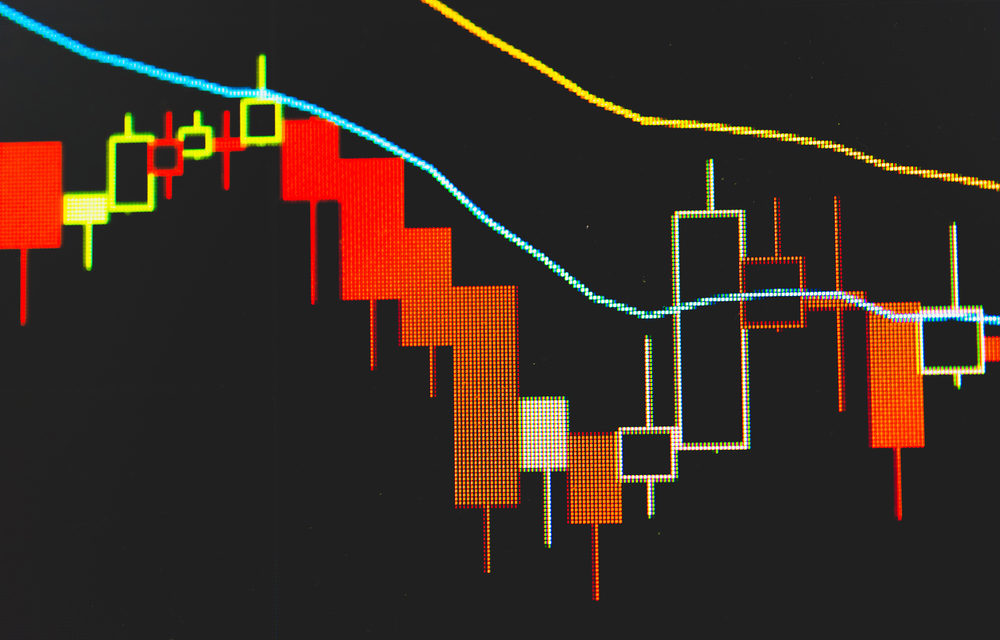One candlestick itself can provide important information about the strength or weakness of the market during a given day or other time period, visually portraying where the close is relative to the open. Although one candle can be significant, depending upon its location on a chart, a candlestick pattern usually takes several candlesticks to produce chart formations that give the best signals. Candlesticks may look identical but have an entirely different meaning after an uptrend than they do after a downtrend.
Because they can be used in analysis in much the same way as bar charts, candlestick charts have quickly become a favorite of traders and analysts since being introduced to the West in 1990. Candlestick analysts have also added a little mystique to candlestick charts by giving various patterns clever names and providing more descriptive characteristics for these patterns than is the case in typical bar chart analysis. Both types of charts have their double tops, inside days, gaps and other formations. But candlestick analysis ascribes more meaning to the candlestick “bodies” – price action between the open and close – and to the “shadows” or “tails” – price action that takes place outside of the open-close range for a period.
Because of their popularity in recent years, you should become acquainted with the nuances and terms of candlestick charts if you aren’t already.
Candlestick Chart Basics
Japanese traders had been using candlestick charts and categorizing various candlestick chart patterns for centuries before the concept began to draw a lot of attention in the West after several books were published in the English language on candlesticks in the early 1990s.
Steve Nison published the first book, Japanese Candlestick Charting Techniques: A Contemporary Guide to the Ancient Investment Techniques of the Far East, in 1991 and added another book a few years later, Beyond Candlesticks: More Japanese Charting Techniques Revealed. Greg Morris’ book, Candlestick Charting Explained, in 1992 thoroughly described and quantitatively tested candlestick patterns, reporting that many were highly reliable. Since then, a number of other authors have written books on candlestick chart analysis.
Quick Guide to Main Patterns
Candlestick charts give a more visual presentation of price action than traditional bar charts and have become the chart of choice for many technical analysts.
One candle itself can provide important information about the strength or weakness of the market during a given day or other time period, depending where the close is relative to the open. However, a candlestick pattern usually takes several candles to produce chart formations that give the best signals.
The key in candlestick chart analysis is where a given candle or candle formation occurs during the market action. Candlesticks may look identical but have an entirely different meaning after an uptrend than they do after a downtrend.
The diagrams and descriptions below cover only some of the main candlestick patterns, showing the bullish version on the left and bearish version on the right. There are many other candlestick patterns with clever names that chart analysts use.
| Bullish | Description | Bearish |
 |
|
 |
 |
|
 |
 |
|
 |
 |
|
 |
 |
|
 |
 |
|
 |
 |
|
 |
Candlestick Reversal Tops
Candlesticks with similar appearances can signal much different outcomes, depending on whether the individual candle or candlestick formation occurs after an extended downtrend or uptrend or in the middle of a trend. Here are some candlestick signals at tops that suggest the previous uptrend may be ready to reverse into a bearish downtrend.
 |
Hanging Man |
 |
Bearish Engulfing Pattern |
 |
Dark Cloud Cover |
| Stars Stars are reversal patterns. There are four main bearish stars that follow and reverse an uptrend. |
 |
The shooting star has a long upper shadow, a small real body at the lower end of the price range and little or no lower shadow. After an upward move in previous sessions, a strong rally from the open occurs, but the market rejects the high prices and prices collapse back down to close near the open. This means that after early buying enthusiasm on the open, the rally attempt proved unsustainable, an obvious failure of demand. It is more significant if the current open gaps up from the previous real body. |
 |
More significant is the more complex evening star, which comprises three candlesticks: First, a long white candle; second, a gap-higher open and a small real body (black or white), which should be completely above but not touching the real body of the first candle; and third, a black real body that closes well into the white body of the first candlestick. The longer this third black real body, the more meaningful it is. A volume surge on this third black real body would add power to the reversal signal. |
 |
If the middle doji’s shadows are completely above and do not touch the shadows of the first and third candlesticks, the pattern is called an abandoned baby top and is even more significant. |
|
Tri-Star is a rare but significant reversal pattern formed by three dojis, the middle one a doji star that gaps up and away from the previous period’s candlestick. Tri-star often follows a trend of long duration that has run its course. The three dojis clearly indicate a loss of momentum and an exhaustion of the trend. |
 |
Bearish Harami |
 |
Bearish harami cross is a major reversal pattern. In an uptrend, a long white real body is followed by a doji, and that doji is contained within the previous large white body. |
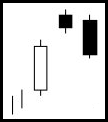 |
Two Crows |
 |
Three Black Crows Three black crows more decisively reverse an existing uptrend. Look for three relatively large, consecutive black candlesticks that close near or at their lows of the period. If the three candlesticks are identical, the pattern is called identical three black crows. |
 |
Belt Hold Belt hold, in an uptrend, forms when prices open much higher on a large window (gap) but close substantially lower, giving up most of the early gain.
|
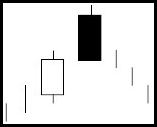 |
Bearish Counterattack Line |
Three Inside Down
Three inside down is composed of three candles. Following a prevailing uptrend, first look for a large white candlestick. This is followed by a short black candlestick, which is entirely contained within the real body of the previous big white candlestick. This suggests some loss of upward price momentum. The third candlestick is a large black candlestick that closes below the lows of the previous two candlesticks, thus confirming a bearish change in trend direction.
Three Outside Down
Three outside down is also composed of three candlesticks. Following a prevailing uptrend, first look for a white candlestick. This is followed by a larger black candlestick, which is an engulfing line – that is, its real body contains the entire previous period’s price range. This alone suggests a change in upward price momentum. The third candlestick is a large black candlestick that closes below the lows of the previous two candlesticks, thus confirming a bearish change in trend direction.
Kicking
Kicking can also be a two-day bull trap. Following a decisive day of buying where prices open on their lows and close on their highs, thus forming a substantial white candle with no shadows, the very next day prices totally reverse on the open, forming a falling window on a large downside opening price gap. Prices close that day on their lows, forming a substantial black candle with no shadows. The bulls can’t help but suffer big losses, and they are likely to be punished by further price weakness in the days ahead, with the market showing no mercy. The bulls suffer a severe kicking.
Deliberation
Deliberation occurs in an uptrend with a three white candlestick pattern where the first two are substantial but the third is small. This indicates a loss of upward momentum, as if the market is preparing for a trend change from up to down.
Advance Block
Advance block occurs in an uptrend when there are three consecutive white candlesticks with the second and the third both exhibiting a smaller price range and real body than the previous one, thus indicating diminishing upward price momentum.
Ladder Top
Ladder top reverses a bullish uptrend. After three consecutive and decisive buying sessions forming three substantial white candlesticks, there may be a noticeable slowing of upward momentum in the fourth period. The trend change from bull to bear is confirmed in the fifth period by a relatively large black candlestick that closes on its low and at a new low relative to the most recent past three periods.
 |
Tweezer Tops |
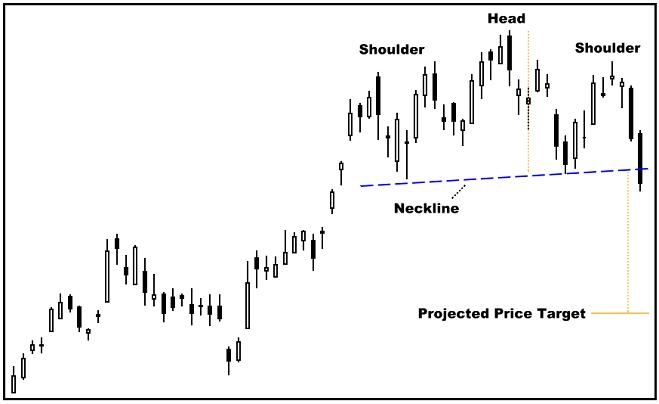
Source: VantagePoint Intermarket Analysis Software
Three Buddha Top
Three Buddha top is a longer-term pattern similar to a Western head-and-shoulders top. A sell signal is confirmed when the price falls below the intervening two minor pullback lows, preferably on a large black candlestick or a falling window (breakaway gap) and a rise in trading volume to indicate serious selling.
Three Mountains Top
Three mountains top is a longer-term pattern similar to a Western triple top. A sell signal is confirmed when the price falls below the intervening two minor pullback lows, preferably on a large black candlestick or a falling window (breakaway gap) and a rise in trading volume to indicate serious selling.
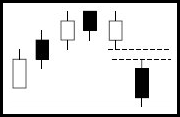 |
Dumping Top Dumping top is a longer-term pattern similar to a Western rounding top, where a sell signal is validated by a falling window (breakaway gap) to indicate overwhelming supply.
|
Eight New Price Lines
Indecision and Continuation Patterns
Individual candlesticks or candlestick patterns tend to be most useful in helping to spot market reversal tops or bottoms, but they can also provide information as a trend is unfolding. Some candlesticks suggest that bullish and bearish traders may have achieved some kind of balance and the market can’t decide which way to go next, or the candlestick pattern may just be setting up to continue the trend that is already in place. “Windows” (gaps to Westerners) could indicate either.
 |
Indecisive Candlesticks |
 |
|
Bullish Doji |
Bearish Doji |
 |
Dragonfly doji has a long lower shadow and no upper shadow. Following an uptrend, it indicates a bearish trend reversal. |
Four price doji has only one price for the period – that is, the open, high, low and close prices are all the same. It indicates an unusually quiet market.
 |
Gravestone doji has a long upper shadow and no lower shadow – that is, the open and close are at the low of the period. Following an uptrend, the longer the upper shadow, the more bearish the indication. Following a downtrend, the gravestone doji can indicate an upside reversal, but that requires a bullish confirmation in the following period. |
Tri-Star is a rare but significant reversal pattern formed by three dojis, the middle one a doji star that gaps away from the previous period’s doji. Tri-Star often follows a trend of long duration that has run its course. The three dojis clearly indicate a loss of momentum and an exhaustion of the existing trend.
 |
Spinning Top |
Continuation Patterns
A continuation pattern suggests that the trend in place should stay in place or resume. Flag formations and triangles in Western analysis are pauses or consolidation areas where the market seems to take a little breather to let prices adjust to conditions. Candlestick charts also feature similar patterns.
 |
Rising Three Methods |
 |
Falling Three Methods |
 Separating lines bullish |
 Separating lines bearish |
Separating Lines
Separating lines are a continuation pattern in either an uptrend or downtrend. In an uptrend, a black candlestick is followed by a white candlestick with the same opening price. In a downtrend, a white candlestick is followed by a black candlestick with the same opening price. In either case, the existing trend continues.
 |
Bullish on Neck Line and in Neck Line Bearish on Neck Line and in Neck Line |
Side-by-Side White Lines
Side-by-side white lines occur after a window (gap) within an existing trend, up or down. The second line is an inside day, with a lower high and higher low. This marks consolidation, and the existing trend quickly resumes.
Windows
The window, known as a gap in the West, occurs anytime when the current price range does not overlap the previous period’s price range. Windows are usually continuation patterns indicating the existing trend before the window is likely to continue after the window. For the trend to continue, the window should function as a support in an uptrend or as resistance in a downtrend. The window should not be closed, or filled in, on a closing price basis. If the window is closed on a closing price basis, the trend is over.
 |
Windows are very powerful and important indications of demand and supply. Windows following congestion patterns validate the new trend direction, giving the same signal as Western breakaway gaps. Rising Window Falling Window |

|
Tasuki Gap |

|
Meeting Line
Meeting line is defined by a window (gap) in the direction of the prevailing trend on the open, but the close reverses to meet the previous period’s close. This should not happen if the trend is to continue, so the trend is likely to reverse.

Source: VantagePoint Intermarket Analysis Software
Three Windows
Three windows often signal the end of a move. The first gap is the breakaway gap that initiates a move. The second gap is a continuation gap or measuring gap that often occurs halfway into a move. The third gap is an exhaustion gap that occurs at the end of a move. Three falling windows are three downside gaps followed by a bullish white candlestick to indicate selling pressure is exhausted. Three rising windows are three upside gaps followed by a bearish black candlestick to indicate buying pressure is exhausted.
The bulls and bears are said to be in a “tug of war” that has reached a standstill. The implication is that whatever trend that existed before the doji now has lost momentum and is vulnerable to correction or reversal so it may be either a bullish or bearish candlestick, depending on its location on the chart. Doji are frequently seen as part of a larger pattern.
Long-legged doji has very long upper and lower shadows and indicates a trend reversal.
Rickshaw man is a specific type of long-legged doji where the open and close are in the middle of the price range.
Candlestick Reversal Bottoms
In addition to depicting the trading action during a given time period more visually, candlestick charts also provide a more visual picture of price reversal patterns signaling the market may be ready to start a new trend.
One candlestick itself can provide important information about the strength or weakness of the market during a given day or other time period and can suggest a price turn. However, it typically takes several candlesticks to produce chart formations that give the best candlestick signals. Of course, much depends on where a given candle or candlestick formation occurs during the market action, a point that cannot be emphasized too much, as candlesticks may look identical but have a different meaning after an uptrend than they do after a downtrend.
Here are some candle signals at a bottom suggesting the previous downtrend should reverse into a bullish uptrend.
 |
Hammer or Shaven Head |
 |
Inverted Hammer or Shaven Bottom |
 |
Bullish Engulfing Pattern |
 |
Piercing Pattern |
Stars
Stars are reversal patterns that can signal either a top or bottom, depending on the previous price trend. There are three main bullish stars that follow and reverse a downtrend.
 |
The morning star is a major bottom reversal signal following a decline. It is comprised of three candlesticks: (1) a long black candle; (2) a gap-lower open and a small real body (black or white) that should be entirely below and not touching the real body of the first candlestick, and (3) a large white real body that closes well into the long black body of the first candlestick. The longer this third white real body, the more meaningful it is. Also, a volume surge on this white real body would add power to the reversal signal. If the middle candle is a doji, the pattern is called a morning doji star and is said to be more meaningful than an ordinary morning star. |
 |
If the middle doji’s shadows are completely below without touching the shadows of the first and third candlesticks, the pattern is called an abandoned baby bottom and is considered to be even more significant. |
 |
Bullish Harami |
 |
Bullish Harami Cross |
 |
Three White Soldiers |
 |
Belt Hold |
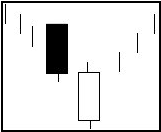 |
Bullish Counterattack Line |
Three Inside Up
Three inside up is composed of three candlesticks. Following a prevailing downtrend, the first is a large black candle. This is followed by a short white candle that is contained entirely within the real body of the previous big black candle. This suggests some loss of downward price momentum. The third candlestick is a large white candlestick that closes above the highs of the previous two candlesticks, thus confirming a bullish change in trend direction.
Three Outside Up
Three outside up is also composed of three candlesticks following a prevailing downtrend. First look for a black candlestick. This is followed by a larger white candlestick that is an engulfing line – that is, its real body contains the entire first period’s price range. This alone suggests a change in downward price momentum. The third candlestick is a large white candle that closes above the highs of the previous two candlesticks, thus confirming a bullish change in trend direction.
Ladder Bottom
Ladder bottom reverses a bearish downtrend. After three consecutive and decisive selling sessions forming three substantial black candles, there may be some slowing of downward momentum in the fourth period. The trend change from bear to bull is confirmed in the fifth period by a relatively large white candlestick that closes on its high and at a new high relative to the most recent past three periods.
Kicking
Kicking is a two-day bear trap. Following a decisive day of selling where prices open on their highs and close on their lows, forming a substantial black candlestick with no shadows, prices totally reverse on the open the very next day, forming a rising window on a large upside opening price gap. Prices close that day on their highs, forming a substantial white candlestick with no shadows. The bears can’t help but suffer big losses, and they are likely to be squeezed further in the days ahead, with the market showing no mercy. The bears suffer a severe kicking.
 |
Tweezer Bottoms |
Three Valleys and Three Rivers
Three valleys bottom and three rivers bottom are longer-term patterns similar to the western world’s triple bottom. A buy signal is confirmed when the price rises above the intervening two rally tops, preferably on a strong, large white candlestick or a rising window (breakaway gap) and a rise in trading volume to indicate strong buying.
Inverted Three Buddha Bottom
Inverted three Buddha bottom is a longer-term pattern similar to a western inverted head-and-shoulders bottom. A buy signal is confirmed when the price rises above the intervening two rally tops, preferably on a strong, large white candlestick or a rising window (breakaway gap) and a rise in trading volume to indicate strong buying.
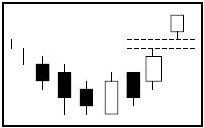 |
Fry Pan Bottom |


